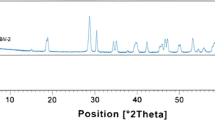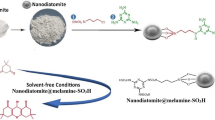Abstract
BiVO4-NPs can be used as a new and efficient nano-catalyst for the promotion of the synthesis of 1,8-dioxo-octahydro xanthenes derivatives. The structures of the products were characterized by their physical properties, comparison with authentic samples and IR, 1H NMR and 13C NMR spectroscopy. Easy preparation of the catalyst, mild reaction conditions, easy work-up procedure, excellent yields and short reaction times are some of the advantages of this work.
Similar content being viewed by others
Background
Xanthenes and their derivatives have received special attention due to their diverse array of biological activities such as anti-inflammatory, antibacterial and antiviral activities [1–3]. Furthermore, these compounds can be used as leuco dyes [4], in laser technology [5] and pH-sensitive fluorescent materials for the visualization of biomolecular assemblies [6]. Because of their wide range of synthetic, industrial and pharmacological applications, there are several reports in the literature for the synthesis of xanthene derivatives.
1,8-Dioxo-octahydro xanthene derivatives are among the most important types of xanthenes and for this reason several methods are reported for the synthesis of 1,8-dioxo-octahydro xanthenes using a variety of catalysts and reagents [7–17].
However, these methods suffer from one or more disadvantages such as: long reaction times, low yields, the use of toxic solvents, requirement of excess of reagents/catalysts and harsh reaction conditions. Therefore, it is important to find more efficient catalysts and methods for the synthesis of these types of compounds.
In recent years and because of the unique properties of nano-particles, synthetic chemists focused on the synthesis and characterization of these types of catalysts with lower dimensions named as nano-catalysts [18].
Results and discussion
In recent years, a considerable amount of our research program is focused on the development of new methods and use of new reagents for the synthesis of xanthenes derivatives [19–25]. In continuation of these studies, we have found that BiVO4-NPs as a newly reported reagent [26] is efficiently able to catalyze the synthesis of 1,8-dioxo-octahydro xanthenes. All reactions are performed under mild reaction conditions in good to high yields.
At the first step and to optimize the reaction conditions, the prepared catalyst was used for the promotion of the condensation of benzaldehyde with dimedone, as a model reaction, and compared the effect of different solvents and solvent-free conditions and also the effect of the catalyst load on the reaction yield and time at thermal conditions (Table 1). On the basis of these studies, we concluded that the best result can be obtained under the conditions showed in Scheme 1.
After optimization of the reaction conditions and to show the general applicability of the method, different types of aromatic aldehydes were subjected to the same reaction under the determined conditions. The obtained results showed that these conversions also were occurred with excellent yields during very short times (Table 2).
It seems that the electronic nature of the functional group on the ring of the aldehyde exerted a slight influence on the reaction time.
A plausible mechanism for the synthesis of 1,8-dioxo-octahydro xanthenes catalyzed by BiVO4-NPs is shown in Scheme 2 [34, 35].
To illustrate the efficiency of the present method, Table 3 compares some of our results obtained from the synthesis of xanthene derivatives with the same results reported by the other groups. This Table clearly shows the applicability and efficiency of the present method. Table 3 also compares the TOF (turnover frequency) of these catalysts in this reaction. As it is clear BiVO4-NPs is superior in terms of TOF to the compared catalysts.
In addition, we decided to study the catalytic activity of the recycled catalyst for the synthesis of xanthenes derivatives. After the separation of the product, the catalyst was washed with acetone and derived at 70 °C. As shown in Fig. 1, BiVO4-NPs can be recycled at least six times without significant decrease in its catalytic activity (Table 2, entry 2).
Conclusion
In conclusion, we have introduced an efficient and convenient approach for the synthesis of 1,8-dioxo-octahydro xanthenes using BiVO4-NPs as a novel nano-catalyst.
This method has several advantages such as: ease of preparation and handling of the catalyst, simplicity and easy work-up, high reaction rates, excellent yields and effective reusability of the catalyst for several times without considerable decrease in yields.
Methods
General
All chemicals were purchased from Merck or Fluka Chemical Companies. All yields refer to the isolated products. Products were characterized by their physical constants and comparison with authentic samples. The purity determination of the substrates and reaction monitoring were accompanied by TLC using silica gel SIL G/UV 254 plates. The FT-IR spectra were run on a VERTEX 70 Brucker company (Germany). The 1H NMR (300, 400 and 500 MHz) and 13C NMR (100 MHz) were run on a Bruker Avance DPX-400 FT-NMR spectrometer (δ in ppm).
General procedure
Synthesis of 1,8-dioxo-octahydro xanthene derivatives
A mixture of dimedone or cyclohexadione (2 mmol), aldehyde (1 mmol) and BiVO4-NPs (20 mg) was stirred at 120 °C under solvent-free conditions for the appropriate time. After completion of the reaction [monitored by TLC: EtOAc: n-hexane (2:8)], the reaction was cooled to room temperature, ethanol (5 mL) was added and the mixture was filtered. Evaporation of the solvent, followed by recrystallization of the residue from EtOH:H2O (95:5) afforded the pure products in good to high yields. The physical and spectral data of the known compounds were in agreement with those reported in the literature.
References
Chatterjee, S., Iqbal, M., Kauer, J.C., Mallamo, J.P., Senadhi, S., Mallya, S., Bozyczko-Coyne, D., Siman, R.: Xanthene derived potent nonpeptidic inhibitors of recombinant human calpain I. Bioorg. Med. Chem. Lett. 6, 1619–1622 (1996)
Vieira, E., Huwyler, J., Jolidon, S., Knofach, F., Mutel, V., Wichmann, J.: Synthesis 12-aryl or 12-alkyl-8,9,10,12-tetrahydrobenzo[a]xanthen-11-one derivatives catalyzed by dodecatungstophosphoric acid. Bioorg. Med. Chem. Lett. 15, 4628–4631 (2005)
Hafez, H.N., Hegab, M.I., Ahmed-Farag, I.S., El-Gazzar, A.B.A.: A facile regioselective synthesis of novel spiro-thioxanthene and spiro-xanthene-9′,2-[1, 3, 4]thiadiazole derivatives as potential analgesic and anti-inflammatory agents. Bioorg. Med. Chem. Lett. 18, 4538–4543 (2008)
Kitahara, Y., Tanaka, K.: Synthesis, crystal structure and properties of thiaheterohelicenes containing phenolic hydroxy functions. Chem. Commun. 932–933 (2002)
Ahmad, M., King, T.A., Ko, D.K., Cha, B.H., Lee, J.: Performance and photostability of xanthene and pyrromethene laser dyes in sol–gel phases. J. Phys. D Appl. Phys. 35, 1473–1476 (2002)
Knight, C.G., Stephens, T.: Xanthene-dye-labelled phosphatidylethanolamines as probes of interfacial pH. J. Biochem. 258, 683–687 (1989)
Dadhania, A.N., Patel, V.K., Raval, D.K.: Catalyst-free sonochemical synthesis of 1,8-dioxo-octahydroxanthene derivatives in carboxy functionalized ionic liquid. C R Chimie. 15(5), 378–383 (2012)
Mulakayala, N., Pavan Kumar, G., Rambabu, D., Aeluri, M., Basaveswara Rao, M.V., Pal, M.: A greener synthesis of 1,8-dioxo-octahydroxanthene derivatives under ultrasound. Tetrahedron Lett. 53(51), 6923–6926 (2012)
Lu, H.Y., Li, J.J., Zhang, Z.H.: ZrOCl2·8H2O: a highly efficient catalyst for the synthesis of 1,8-dioxo-octahydro xanthene derivatives under solvent-free conditions. Appl. Organometal Chem. 23, 165–169 (2009)
Oskooie, H.A., Tahershamsi, L., Heravi, M.M., Baghernejad, B.: Cellulose sulfonic acid: an efficient heterogeneous catalyst for the synthesis of 1,8-dioxo-octahydro xanthenes. J. Chem. 7, 717–720 (2010)
Bigdeli, M.: Clean synthesis of 1,8-dioxo-octahydro xanthenes promoted by DABCO–bromine in aqueous media. Chin. Chem. Lett. 21, 1180–1182 (2010)
Rostamizadeh, S., Amani, A.M., Mahdavinia, G.H., Amiri, G., Sepehrian, H.: Ultrasound promoted rapid and green synthesis of 1,8-dioxo-octahydro xanthenes derivatives using nanosized MCM-41-SO3H as a nanoreactor, nanocatalyst in aqueous media. Ultrason. Sonochem. 17, 306–309 (2010)
Javid, A., Heravi, M.M., Bamoharram, F.F.: One-pot synthesis of 1,8-dioxo-octahydro xanthenes utilizing silica-supported preyssler nano particles as novel and efficient reusable heterogeneous acidic catalyst. E-J. Chem. 8, 910–916 (2011)
Mosaddegh, E., Islami, M.R., Hassankhani, A.: ZrOCl2·8H2O as an efficient and recyclable catalyst for the clean synthesis of xanthenedione derivatives under solvent-free conditions. Arab. J. Chem. 5, 77–80 (2012)
Zolfigol, M.A., Khakyzadeh, V., Moosavi-Zare, A.R., Zare, A., Azimi, S.B., Asgari, Z., Hasaninejad, A.: Preparation of various xanthene derivatives over sulfonic acid functionalized imidazolium salts (SAFIS) as novel, highly efficient and reusable catalysts. C R Chimie. 15, 719–736 (2012)
Khaksar, S., Behzadi, N.: Mild and highly efficient method for synthesis of 14-aryl(alkyl)-14H-dibenzo[a, j]xanthenes and 1,8-dioxo-octahydro xanthene derivatives using pentafluorophenyl ammonium triflate as a novel organocatalyst. Chin. J. Catal. 33, 982–985 (2012)
Venkatesan, K., Pujari, S.S., Lahoti, R.J., Srinivasan, K.V.: An efficient synthesis of 1,8-dioxo-octahydro-xanthene derivatives promoted by a room temperature ionic liquid at ambient conditions under ultrasound irradiation. Ultrason. Sonochem. 15, 548–553 (2008)
Shirini, F., Abedini, M.: Application of nanocatalysts in multi-component reactions. J. Nanosci. Nanotechnol. 13, 4838–4860 (2013)
Shirini, F., Imanzadeh, G.H., Abedini, M., Akbari-Dokhte-Ghaziani, M., Ghods Ghasemabadi, P., Safarpoor Langroodi, M.: Introduction of two efficient catalysts for the synthesis of 1,8-dioxo-octahydro xanthene derivatives in the absence of solvent. Iran. J. Catal. 2, 115–119 (2012)
Shirini, F., Khaligh, N.G., Ghods Ghasemabadi, P.: 1,3-Dibromo-5,5-dimethylhydantoin (DBH)/kaolin: an efficient reagent system for the synthesis of 14-aryl-14H-dibenzo[a, j]xanthenes under solvent-free conditions. Chin. Chem. Lett. 23, 1145–1148 (2012)
Shirini, F., Khaligh, N.G.: Succinimide-N-sulfonic acid: an efficient catalyst for the synthesis of xanthenes derivatives under solvent-free conditions. Dyes Pigment. 95, 789–794 (2012)
Shirini, F., Imanzadeh, G.H., Abedini, M., Ghods Ghasemabadi, P.: 1,3-Dibromo-5,5-dimethylhydantoin (DBH) as a cheap and efficient catalyst for the synthesis of polyhydroquinolines and 12-aryl-8,9,10,12-tetrahydro [a] xanthene-11-ones. Iran. J. Catal. 3, 57–65 (2013)
Shirini, F., Abedini, M., Pourhasan, R.: N-sulfonic acid poly(4-vinylpyridinium) chloride: a novel polymeric and reusable catalyst for the preparation of xanthenes derivative. Dyes Pigment. 99, 250–255 (2013)
Shirini, F., Akbari-Dadamahaleh, S., Mohammad-Khah, A.: Rice-husk-supported FeCl3 nano-particles: introduction of a mild, efficient and reusable catalyst for some of the multi-component reactions. C R Chimie. 16, 945–955 (2013)
Shirini, F., Abedini, M., Akbari-Dadamahaleh, S., Rahmaninia, A.: Iranian chemist’s efforts to provide various effective methods for the synthesis of xanthenes. J. Iran. Chem. Soc. 11, 791–824 (2014)
Golmojdeh, H., Zanjanchi, M.A.: A facile approach for synthesis of BiVO4 nano particles possessing high surface area and various morphologies. Cryst. Res. Technol. 47, 1014–1025 (2012)
Maleki, B., Barzegar, S., Sepehr, Z., Kermanian, M., Tayebee, R.: A novel polymeric catalyst for the one-pot synthesis of xanthene derivatives under solvent-free conditions. J. Iran. Chem. Soc. 9, 757–765 (2012)
Niknam, K., Damya, M.: 1-Butyl-3-methylimidazolium hydrogen sulfate [bmim]HSO4: an efficient reusable acidic ionic liquid for the synthesis of 1,8-dioxo-octahydro xanthenes. J. Chin. Chem. Soc. 56, 659–665 (2009)
Ilangovan, A., Muralidharan, S., Sakthivel, P., Malayappasamy, S., Karuppusamy, S., Kaushik, M.P.: Simple and cost effective acid catalysts for efficient synthesis of 9-aryl-1,8-dioxo-octahydro xanthene. Tetrahedron Lett. 54, 491–494 (2013)
John, A., Yadav, P.J.P., Palaniappan, S.: Clean synthesis of 1,8-dioxo-dodecahydroxanthene derivatives catalyzed by polyaniline-p-toluenesulfonate salt in aqueous media. J. Mol. Catal. A Chem. 248, 121–125 (2006)
Seyyedhamzeh, M., Mirzaei, P., Bazgir, A.: Solvent-free synthesis of aryl-14H-dibenzo[a, j]xanthenes and 1,8-dioxo-octahydro xanthenes using silica sulfuric acid as catalyst. Dyes Pigment. 76, 836–839 (2008)
Mohammadpoor-Baltork, I., Moghadam, M., Mirkhani, V., Tangestaninejad, S., Tavakoli, H.R.: Highly efficient and green synthesis of 14-aryl(alkyl)-14H-dibenzo[a, j]xanthene and 1,8-dioxooctahydroxanthene derivatives catalyzed by reusable zirconyl triflate [ZrO(OTf)2] under solvent-free conditions. Chin. Chem. Lett. 22, 9–12 (2011)
Rashedian, F., Saberi, D., Niknam, K.: Silica-bonded N-propyl sulfamic acid: a recyclable catalyst for the synthesis of 1,8-dioxo-decahydroacridines, 1,8-dioxo-octahydro xanthenes and uinoxalines. J. Chin. Chem. Soc. 57, 998–1006 (2010)
Ghasemzadeh, M.A., Safaei-Ghomi, J., Zahedi, S.: Fe3O4 nanoparticles: a highly efficient and easily reusable catalyst for the one-pot synthesis of xanthene derivatives under solvent-free conditions. J. Serb. Chem. Soc. 78, 769–779 (2013)
Safaei-Ghomi, J., Ghasemzadeh, M.A.: Zinc oxide nanoparticles: a highly efficient and readily recyclable catalyst for the synthesis of xanthenes. Chin. Chem. Lett. 23, 1225–1229 (2012)
Acknowledgments
The authors are thankful to the Guilan University Research Council for the partial support of this work.
Author information
Authors and Affiliations
Corresponding author
Rights and permissions
Open Access This article is distributed under the terms of the Creative Commons Attribution License which permits any use, distribution, and reproduction in any medium, provided the original author(s) and the source are credited.
About this article
Cite this article
Shoja, A., Shirini, F., Abedini, M. et al. BiVO4-NPs as a new and efficient nano-catalyst for the synthesis of 1,8-dioxo-octahydro xanthenes. J Nanostruct Chem 4, 110 (2014). https://doi.org/10.1007/s40097-014-0110-5
Received:
Accepted:
Published:
DOI: https://doi.org/10.1007/s40097-014-0110-5







